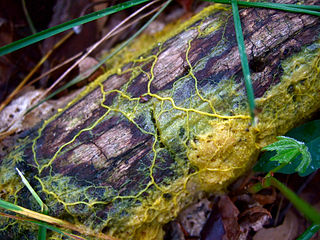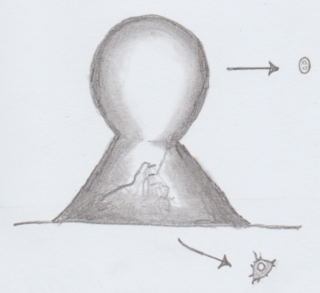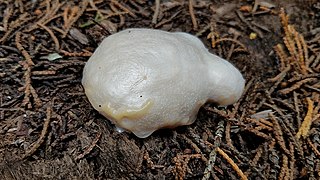
Asexual reproduction is a type of reproduction which does not involve the fusion of gametes or change in the number of chromosomes. The offspring that arise by asexual reproduction from a single cell or from a multicellular organism inherit the genes of that parent. Asexual reproduction is the primary form of reproduction for single-celled organisms such as archaea and bacteria. Many multicellular animals, plants and fungi can also reproduce asexually.

A flagellate is a cell or organism with one or more whip-like appendages called flagella. The word flagellate also describes a particular construction characteristic of many prokaryotes and eukaryotes and their means of motion. The term presently does not imply any specific relationship or classification of the organisms that possess flagellae. However, the term "flagellate" is included in other terms which are more formally characterized.

Slime mold or slime mould is an informal name given to several kinds of unrelated eukaryotic organisms that can live freely as single cells, but can aggregate together to form multicellular reproductive structures. Slime molds were formerly classified as fungi but are no longer considered part of that kingdom. Although not forming a single monophyletic clade, they are grouped within the paraphyletic group referred to as kingdom Protista.

Ascomycota is a phylum of the kingdom Fungi that, together with the Basidiomycota, forms the subkingdom Dikarya. Its members are commonly known as the sac fungi or ascomycetes. It is the largest phylum of Fungi, with over 64,000 species. The defining feature of this fungal group is the "ascus", a microscopic sexual structure in which nonmotile spores, called ascospores, are formed. However, some species of the Ascomycota are asexual, meaning that they do not have a sexual cycle and thus do not form asci or ascospores. Familiar examples of sac fungi include morels, truffles, brewer's yeast and baker's yeast, dead man's fingers, and cup fungi. The fungal symbionts in the majority of lichens such as Cladonia belong to the Ascomycota.

Mycetozoa is a polyphyletic grouping of slime molds.

Multicellular organisms are organisms that consist of more than one cell, in contrast to unicellular organisms.
A coenocyte is a multinucleate cell which can result from multiple nuclear divisions without their accompanying cytokinesis, in contrast to a syncytium, which results from cellular aggregation followed by dissolution of the cell membranes inside the mass. The word syncytium in animal embryology is used to refer to the coenocytic blastoderm of invertebrates. Coenocytic cells are referred to as a coenobium, and most coenobia are composed of a distinct number of cells, often as a multiple of two.
A syncytium or symplasm is a multinucleated cell that can result from multiple cell fusions of uninuclear cells, in contrast to a coenocyte, which can result from multiple nuclear divisions without accompanying cytokinesis. The term may also refer to cells interconnected by specialized membranes with gap junctions, as seen in the heart muscle cells and certain smooth muscle cells, which are synchronized electrically in an action potential.
A heterokaryon is a multinucleate cell that contains genetically different nuclei. Heterokaryotic and heterokaryosis are derived terms. This is a special type of syncytium. This can occur naturally, such as in the mycelium of fungi during sexual reproduction, or artificially as formed by the experimental fusion of two genetically different cells, as e.g., in hybridoma technology.

Isogamy is a form of sexual reproduction that involves gametes of similar morphology, differing in general only in allele expression in one or more mating-type regions. Because both gametes look alike, they cannot be classified as "male" or "female". Instead, organisms undergoing isogamy are said to have different mating types, most commonly noted as "+" and "−" strains, although in some species of Basidiomycota there are more than two mating types. In all cases, fertilization occurs when gametes of two different mating types fuse to form a zygote.
The dikaryon is a nuclear feature which is unique to some fungi. The green alga Derbesia has been long considered an exception, until the heterokaryotic hypothesis was challenged by later studies. Compatible cell-types can fuse cytoplasms (plasmogamy). When this occurs, the two nuclei of two cells pair off and cohabit without fusing (karyogamy). This can be maintained for all the cells of the hyphae by synchronously dividing so that pairs are passed to newer cells. In the Ascomycota this attribute is most often found in the ascogenous hyphae and ascocarp while the bulk of the mycelia remains monokaryotic. In the Basidiomycota this is the dominant phase with most Basidiomycota monokaryons weakly growing and short-lived.

Physarum polycephalum, an acellular slime mold or myxomycete, is a protist with diverse cellular forms and broad geographic distribution. The “acellular” moniker derives from the plasmodial stage of the life cycle: the plasmodium is a bright yellow macroscopic multinucleate syncytium shaped in a network of interlaced tubes. This stage of the life cycle, along with its preference for damp shady habitats, likely contributed to the original mischaracterization of the organism as a fungus. P. polycephalum is used as a model organism for research into motility, cellular differentiation, chemotaxis, cellular compatibility, and the cell cycle.
Multinucleate cells are eukaryotic cells that have more than one nucleus per cell, i.e., multiple nuclei share one common cytoplasm. Mitosis in multinucleate cells can occur either in a coordinated, synchronous manner where all nuclei divide simultaneously or asynchronously where individual nuclei divide independently in time and space. Certain organisms may have a multinuclear stage of their life cycle. For example, slime molds have a vegetative, multinucleate life stage called a plasmodium.

Fuligo septica is a species of plasmodial slime mold, and a member of the Myxomycetes class. It is commonly known as the scrambled egg slime, or flowers of tan because of its peculiar yellowish, bile-colored appearance. Also known as the dog vomit slime mold, it is common with a worldwide distribution, and it is often found on bark mulch in urban areas after heavy rain or excessive watering. Their spores are produced on or in aerial sporangia and are spread by wind.

Myxogastria/Myxogastrea or Myxomycetes (ICBN), is a class of slime molds that contains 5 orders, 14 families, 62 genera and 888 species. They are colloquially known as the plasmodial or acellular slime moulds.

Trichiida is an order of slime moulds in the phylum Amoebozoa. Trichiida is one of five orders in the group Myxomycetes, or the true plasmodial slime molds. It is also currently categorized under the superorder Lucisporidia with its sister group, Liceida. The order was first described by Thomas MacBride in 1922, and has retained the same name and status as a defined order in present phylogeny. In the plasmodium form, members of Trichiida lack a columella but have a well-developed capillitium for spore dispersal. The shape and details of the capillitium are used to define families within the order. Spores are brightly coloured, ranging from clear, white and yellow to pink and red-brown tones. The order currently has 4 families, 14 genera and 174 species. Recent molecular research has shown that while Trichiida probably represents a true taxonomic group, its sister group Liceida is likely paraphyletic, and it has been suggested that several genera from the Liceida should be reclassified under Trichiida instead.

Fonticula is a genus of cellular slime mold which forms a fruiting body in a volcano shape. As long ago as 1979 it has been known to not have a close relationship with either the Dictyosteliida or the Acrasidae, the two well-established groups of cellular slime molds. In 1979, Fonticula was made a new genus of its own due to the unique characteristics of its fruiting body, with only one species: Fonticula alba.

The False Puffball, Enteridium lycoperdon, is one of the more obvious species of slime mould or Myxogastria, typically seen in its reproductive phase as a white 'swelling' on standing dead trees in the spring, or on large pieces of fallen wood. Alder is a common host.

An amoeba or ameba, often called an amoeboid, is a type of cell or unicellular organism which has the ability to alter its shape, primarily by extending and retracting pseudopods. Amoebae do not form a single taxonomic group; instead, they are found in every major lineage of eukaryotic organisms. Amoeboid cells occur not only among the protozoa, but also in fungi, algae, and animals.

Vampyrella is a genus of amoebae belonging to the vampyrellid cercozoans usually ranging from 30-60 um. Members of the genus alternate between two life stages: a free-living trophozoite stage and a cyst stage in which mitosis occurs. This taxon has received a great deal of attention due to their peculiar feeding behaviour of perforating the cell wall of algal cells and drawing out the contents for nourishment.















